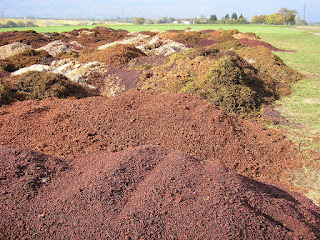Recycling, or re-use, is an important concept in the modern world. For example, where I live, the supermarket car-parks have bins where we can recycle: clear glass, colored glass, plastic containers, cardboard containers, metal containers, and newspapers (see the picture). My household collection has one roadside bin for compostable material, and a separate one for refuse. *
So, it is hardly surprising that the wine industry is involved as well.
We all should know that compost and mulch are of great benefit when growing plants. Since grape-vines are plants, this applies to them as well — for some details, see Vineyards benefit from compost and mulch (from UC Berkeley) or Compost as mulch for vineyards (from CSIRO, Australia). One of the key components is carbon, and soil contains about twice as much carbon as the atmosphere and plants combined (A new estimate of US soil organic carbon to improve earth system models). There is growing recognition that agriculture should invest in building up this level through sustainable land management practices.
However, the wine industry sometimes goes further, by way of providing monetary incentives. For example, the California Association of Winegrape Growers has announced the California Compost Tax Credit Legislation. This legislation “seeks to incentivize sustainable agricultural practices, undertaken by winegrape growers and other ag producers, by offering a tax credit for the utilization of compost to enhance carbon sequestration efforts.” Other wine-grape regions should follow suit, around the world.
Moreover, we can also go one step further than this, into a broader perspective.
Obviously, what are usually called “winery wastes and by-products” are organic matter, and thus eminently suitable for re-use. The main solid by-product generated through winemaking is called Grape Pomace (GP). It comprises skins, seeds, stems, and disrupted cells from the grape pulp, and is reported to represent 20–25% of the total weight of processed grapes. So, there have been suggestions that we need to plan for its sustainable disposal.
This topic has recently been reviewed in: Grape pomace — advances in its bioactivity, health benefits, and food applications. The first step is what is fancifully called ‘valorization’, which simply means working out what each of the pomace components is worth, in terms of future use, such as offering new functional foods, but also contributing to solve waste management problems in the wine industry.
It is noted that GP comprises nutritional and bioactive compounds (eg. polyphenols, organic and fatty acids, vitamins, etc). Particularly, GP polyphenols have been recognized as exhibiting technological and health-promoting effects in different food and biological systems. This could be used as a food additive / ingredient in the development of novel food products (eg. enhancement of physicochemical, sensory and nutritional quality), along with technological and functional advantages. So, the review paper summarizes the current knowledge about the bioactivity and health–promoting effects of polyphenolic–rich extracts. There seems to be enormous potential; and the grape industry should be actively involved.
There is also the matter of organic viticulture (also called biodynamic farming, which name is celebrating its 100th anniversary this June) — this seeks to leave the vineyard as natural as possible. For further information, this is discussed in a multi–part web resource by Britt Karlsson, at: Organic, biodynamic and sustainable wine, an overview.
This approach can be taken even further, by adopting what might be called ‘regenerative’ practices. This basically involves leaving the ground undisturbed (ie. no ploughing of the soil), and also keeping the ground permanently covered with vegetation. This aims to increase the microbiological life and carbon content in the vineyard soils. One interesting example of this approach, aiming to re-instate the native vegetation where possible, is discussed in: Why Doña Paula is embracing nature in Argentina.
As a final point, at the moment it seems that re-cycling / re-using is one area in which Artificial Intelligence is not yet involved for the wine industry (What’s ahead for wine and artificial intelligence?). Currently, AI seems to be focused on productivity gains, rather than environmental sustainability. After all, in France, Bordeaux wine is now cheaper than bottled water (Winemakers’ anger over €1.66 Bordeaux wine)! You could also check out: A new definition for natural wine: it’s the people who are “natural”, not the wine (no AI here).
[Don’t miss last week’s short post on Easter and wine]
* I gather that in California, all of this recycling is done via three kerbside bins.





It causes me anguish when I see wineries using pomace for dust control on lanes, washing lees down a drain.
ReplyDeleteThis is not “waste” this is our soil. The parts that leave as wine are components made almost enough H, O, C. Easy to obtain from the atmosphere. The lees and pomace contain the N, P, K, B etc.
As an estate winery I’ve returned those things called waste to the vineyard. I don’t use fertilizer from off farm, I’ve successfully avoided using any type of pesticide since 2012. I’ve increased my SOM(soil organic material) into the top percentile in our region.
My soils have adequate N, since soil microbes can fix it from the atmosphere, legumes not required.
I’m not Biodynamic, I didn’t go to Hogworts to learn potion(preparation) making.
Real Organic is regenerative, unfortunately USDA Organic has lost it’s way.
It sounds like you are keen to do the right thing. What you are doing may not officially be Biodynamic, but it seems to come close to the original intention.
Delete